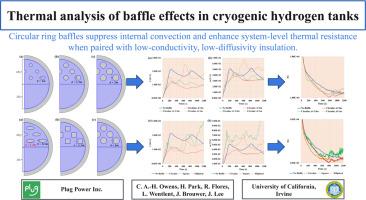Thermal analysis of baffle effects in cryogenic hydrogen tanks
IF 5.8
2区 工程技术
Q1 ENGINEERING, MECHANICAL
International Journal of Heat and Mass Transfer
Pub Date : 2025-09-25
DOI:10.1016/j.ijheatmasstransfer.2025.127863
引用次数: 0
Abstract
Minimizing heat ingress into cryogenic storage tanks is a key challenge in thermal system design. While prior studies have examined insulation materials or baffle effects in isolation, the coupled influence of these mechanisms on overall thermal resistance remains underexplored. This study introduces a novel approach that parameterizes baffle geometry and size and couples it with insulation performance by evaluating how baffle configurations influence both internal convection and insulation resistance in a two-phase cryogenic hydrogen tank. A 2D axisymmetric model at 50 % fill level is simulated under transient conditions using commercial multiphysics simulation software, with the working fluid initially at saturation temperature and standard atmospheric pressure. The model is validated against experimental LH2 tank studies, with strong agreement in both liquid and vapor phase temperature trends. Increasing circular ring baffle diameter from 1 meter to 2 meters reduces the average Nusselt number by 16 %, velocity magnitude by 44 %, and vorticity magnitude by 17 % compared to the no-baffle case. The optimal 2 m baffle is used to assess insulation-baffle coupling, revealing that baffle inclusion increases the convective-to-conductive resistance ratio by up to 30 % at low insulation thermal conductivities but diminishes to 4 % as conductivity rises. Geometric analysis shows that curved baffles outperform rectangular designs through smoother boundary layer development, stabilizing flow, and suppressing convective transport. These findings establish that thermal performance in cryogenic tanks depends on coupled design variables, underscoring the need to jointly optimize baffle structure and insulation properties rather than treating them as isolated components.

低温氢罐挡板效应的热分析
低温储罐的热输入最小化是热系统设计的关键挑战。虽然先前的研究已经单独检查了绝缘材料或挡板效应,但这些机制对整体热阻的耦合影响仍未得到充分探讨。本研究引入了一种新的方法,通过评估两相低温氢气罐中挡板配置对内部对流和保温阻力的影响,将挡板的几何形状和尺寸参数化,并将其与保温性能相结合。利用商业多物理场模拟软件,在饱和温度和标准大气压条件下,模拟了50%充填水平下的二维轴对称模型。该模型通过LH2罐实验研究进行了验证,在液相和气相温度趋势上都有很强的一致性。与无挡板的情况相比,将环形挡板直径从1米增加到2米,平均努塞尔数减少16%,速度大小减少44%,涡量大小减少17%。最佳的2米挡板被用来评估绝缘-挡板耦合,结果表明,在低绝缘导热系数下,挡板的加入使对流-导电电阻比增加了30%,但随着导热系数的增加而减少到4%。几何分析表明,弯曲折流板通过更平滑的边界层发展、稳定流动和抑制对流输送,优于矩形设计。这些发现表明,低温储罐的热性能取决于耦合设计变量,强调需要共同优化挡板结构和隔热性能,而不是将它们视为孤立的部件。
本文章由计算机程序翻译,如有差异,请以英文原文为准。
求助全文
约1分钟内获得全文
求助全文
来源期刊
CiteScore
10.30
自引率
13.50%
发文量
1319
审稿时长
41 days
期刊介绍:
International Journal of Heat and Mass Transfer is the vehicle for the exchange of basic ideas in heat and mass transfer between research workers and engineers throughout the world. It focuses on both analytical and experimental research, with an emphasis on contributions which increase the basic understanding of transfer processes and their application to engineering problems.
Topics include:
-New methods of measuring and/or correlating transport-property data
-Energy engineering
-Environmental applications of heat and/or mass transfer

 求助内容:
求助内容: 应助结果提醒方式:
应助结果提醒方式:


